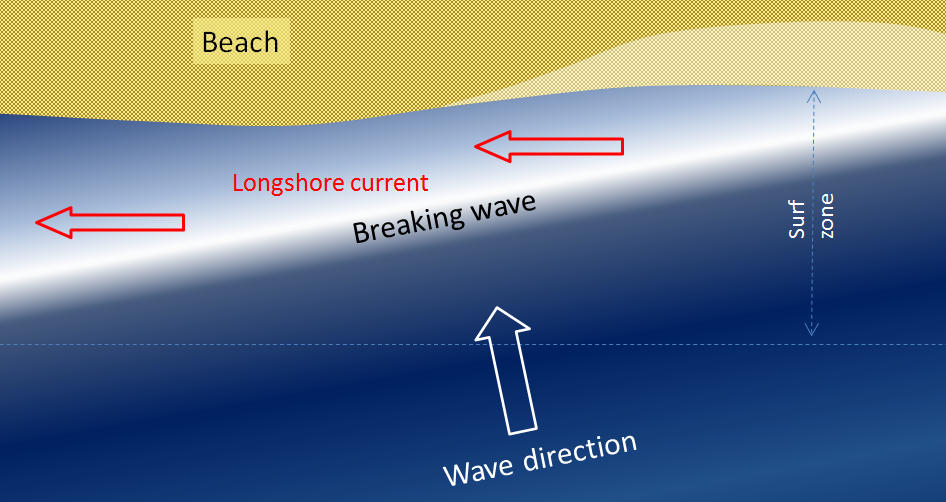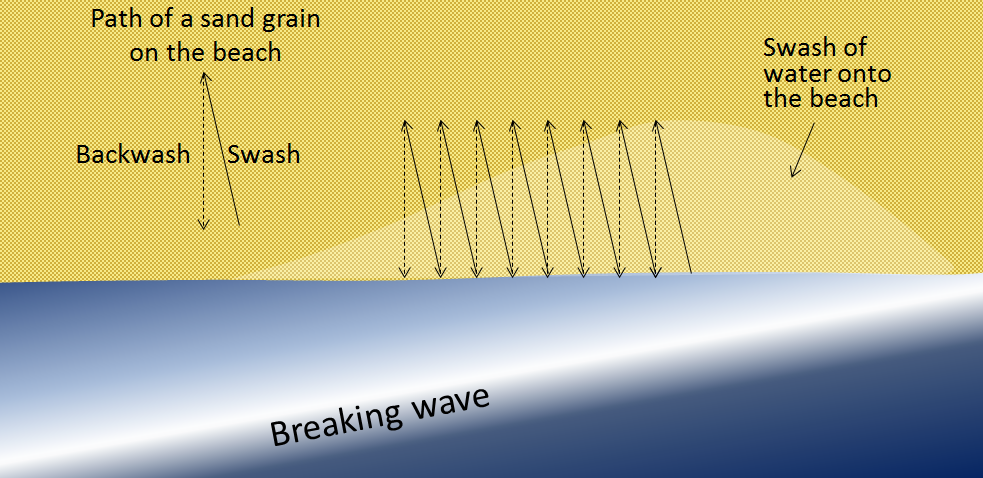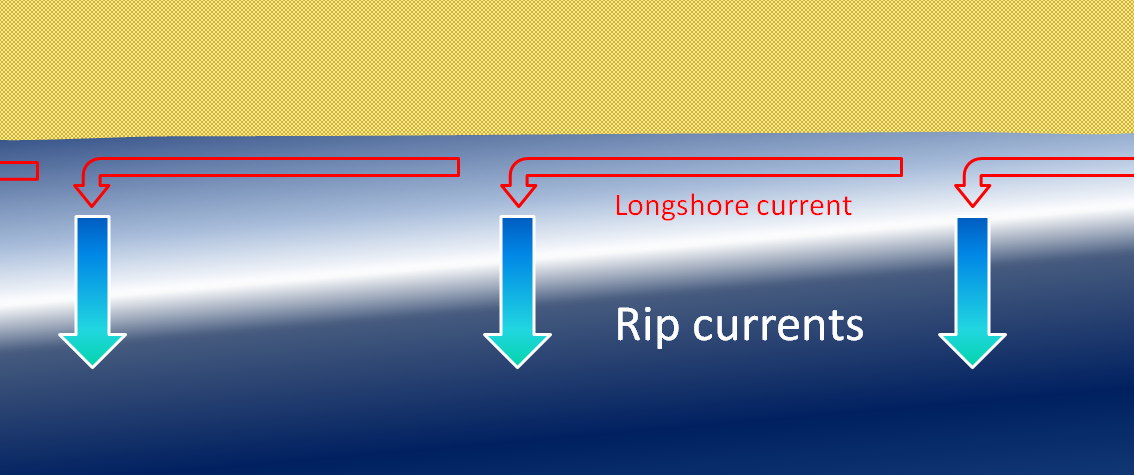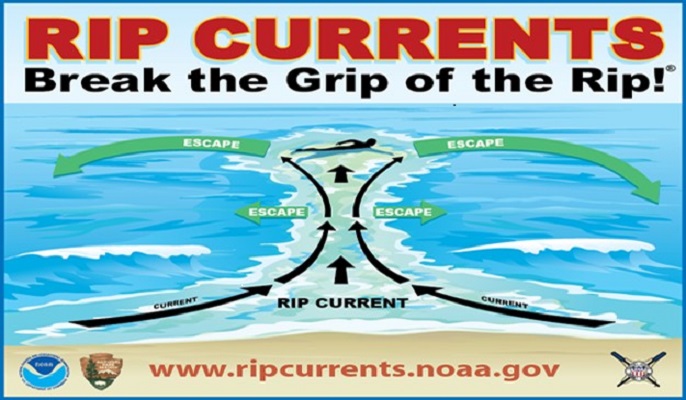8.3 Waves and Shoreline Currents
Waves
Waves form on the ocean and lakes because energy from the wind is transferred to the water. The stronger the wind, the longer it blows, and the larger the area of water over which it blows (the fetch), the larger the waves are likely to be.
The essential parameters of a wave are its wavelength (the horizontal distance between two crests or two troughs), its amplitude (the vertical distance between a trough and a crest), and its velocity (the speed at which wave crests move across the water). Relatively small waves move up to about 10 km/h and arrive on a shore about once every 3 seconds. Huge waves move about five times faster (over 50 km/h), but because their wavelengths are so much longer, they arrive less often – about once every 14 seconds. (4)
As a wave moves across the water’s surface, the water itself mostly moves up and down and only moves a small amount in the direction of wave motion. As this happens, a point on the water surface describes a circle with a diameter equal to the wave amplitude. This motion is also transmitted to the water underneath, and the water is disturbed by a wave to a depth of approximately one-half of the wavelength. (1)

The one-half wavelength depth of disturbance of the water beneath a wave is known as the wave base. Since ocean waves rarely have wavelengths higher than 200 m, and the open ocean is several thousand meters deep, the wave base does not frequently interact with the ocean’s bottom. However, as waves approach the much shallower water near the shore, they start to “feel” the bottom, and they are affected by that interaction. The wave “orbits” are both flattened and slowed by dragging, and the implications are that the wave amplitude (height) increases, and the wavelength decreases (the waves become much steeper). The ultimate result of this is that the waves lean forward, and eventually break. (4)

Shoreline Currents
Waves usually approach the shore at an angle, and this means that one part of the wave feels the bottom sooner than the rest of it, so the part that feels the bottom first slows down first. In open water, these waves had wavelengths close to 100 m. In the shallow water closer to shore, the wavelengths decreased to around 50 m, and in some cases, even less. Even though they bend and become nearly parallel to the shore, most waves still reach the shore at a small angle, and as each one arrives, it pushes water along the shore, creating what is known as a longshore current within the surf zone where waves are breaking. (3)

Another significant effect of waves reaching the shore at an angle is that when they wash up onto the beach, they do so at an angle, but when that same wave water washes back down the beach, it moves straight down the slope of the beach. Figure 8.2.2 shows the upward-moving water, known as the swash, pushes sediment particles along the beach, while the downward-moving water, the backwash, brings them straight back. With every wave that washes up and down the beach, particles of sediment are moved along the beach in a zigzag pattern. (1)

The combined effects of sediment transport within the surf zone by the longshore current and sediment movement along the beach by swash and backwash is known as longshore drift. Longshore drift moves a tremendous amount of sediment along coasts (both oceans and large lakes) around the world, and it is responsible for creating a variety of depositional features. A rip current is another type of current that develops in the nearshore area and has the effect of returning water that has been pushed up to the shore by incoming waves. If part of a beach does not have a strong unidirectional longshore current, the rip currents may be fed by longshore currents going in both directions. (1)

Hazards associated with waves and currents
Any place where the ocean and land are in contact can pose a hazard to people. Rip currents flow straight out from the shore and are fed by the longshore currents. They die out quickly outside the surf zone but can be dangerous to swimmers who get caught in them. Typically they reach speeds of 1 to 2 feet per second, but some have been measured at 8 feet per second, faster than an Olympic swimmer. Because rip currents move perpendicular to shore and can be very strong, beach swimmers need to be careful. A person caught in a rip can be swept away from shore quickly. The best way to escape a rip current is by swimming parallel to the shore instead of towards it, since most rip currents are less than 80 feet wide. A swimmer can also let the current carry him or her out to sea until the force weakens, because rip currents stay close to shore and usually dissipate just beyond the line of breaking waves. Occasionally, however, a rip current can push someone hundreds of yards offshore. The most important thing to remember if you are ever caught in a rip current is not to panic. Continue to breathe, try to keep your head above water, and don’t exhaust yourself fighting against the force of the current. (6)

Storm Surge
In coastal areas, most of the damage done by tropical storms is from storm surges. The water piles up at a shoreline as storm winds push waves into the coast. Storm surge may raise sea level by 9.1 m (30 ft) or more, which can be devastating in a shallow land area when winds, waves, and rain are heavy. Storm surges can cause extensive damages, eroding beaches and coastal highways, destroying buildings and boats, and affecting inland rivers and lakes. The following videos will explain further what happens during a hurricane storm surge and what are how we mitigate or prevent further damage.
Video 8.3.1. Storm surge is water from the ocean that is pushed toward the shore by the force of the winds swirling around the hurricane. It is the greatest threat to life during a hurricane. Source: NOAA (2:35).
To better respond to storm surges, scientists forecast the extent of flooding using computer models. Geographic Information Systems, GIS, are key to simulate and visualize the impacts of a surge. Scientists then work with governors and agencies to plan, prepare and respond when a surge happens.
Video 8.3.2. Major storm surge is forecasted for coastal areas in the US due to Hurricane Irma.
Key Takeaways
Storm surge is the most deadly part of a hurricane or tropical storm.
Be prepared — during a storm surge event stay tuned to NOAA Weather Radio or television station and listen carefully for any advisories or specific instructions from local officials.
Tsunamis
A particular type of wave is generated by an energetic event affecting the seafloor, such as earthquakes, submarine landslides, and volcanic eruptions. Called tsunamis, these waves are created when a portion of the seafloor is suddenly elevated by movement in the crustal rocks below that are involved in an earthquake. The water is suddenly lifted, and a wave train spreads out in all directions from the mound carrying enormous energy and traveling very fast (hundreds of miles per hour). A series of long-period waves (on the order of tens of minutes) that are usually generated by an impulsive disturbance that displaces massive amounts of water, such as an earthquake occurring on or near the sea floor. Underwater volcanic eruptions and landslides can also cause tsunami. The resultant waves much the same as waves propagating in a calm pond after a rock is tossed. While traveling in the deep oceans, tsunami have extremely long wavelengths, often exceeding 50 nm, with small amplitudes (a few tens of centimeters) and negligible wave steepness, which in the open ocean would cause nothing more than a gentle rise and fall for most vessels, and possibly go unnoticed. Tsunami travel at very high speeds, sometimes in excess of 400 knots. Across the open oceans, these high-speed waves lose very little energy. As tsunami reach the shallow waters near the coast, they begin to slow down while gradually growing steeper, due to the decreasing water depth, much in the same way that wind waves form (Figure 8.2.1). The building walls of destruction can become extremely large in height, reaching tens of meters or more as they reach the shoreline. The effects can be further amplified where a bay, harbor, or lagoon funnels the waves as they move inland. Large tsunami have been known to rise to over 100 feet! The amount of water and energy contained in tsunami can have devastating effects on coastal areas. (6)
Video 8.3.3. Brief video summarizing the causes an effects of a tsunami (0:59).
Distance between crests or troughs of a wave.
maximum height of a wave
lowest point in a wave
highest point in a wave
Area of water between the high tide level on the beach and the seaward side of the breaking waves.
upward movement of water on a beach
downward moving water on a beach
A relatively small-scale surf-zone current moving away from the beach. Rip currents form as waves disperse along the beach causing water to become trapped between the beach and a sandbar or other underwater feature. The water converges into a narrow, river-like channel moving away from the shore at high speed.
An abnormal rise in sea level accompanying a hurricane or other intense storm, whose height is the difference between the observed level of the sea surface and the level that would have occurred in the absence of the cyclone. Storm surge is usually estimated by subtracting the normal or astronomic tide from the observed storm tide.
A series of long-period waves generated by an impulse disturbance that displaces massive amounts of water.

